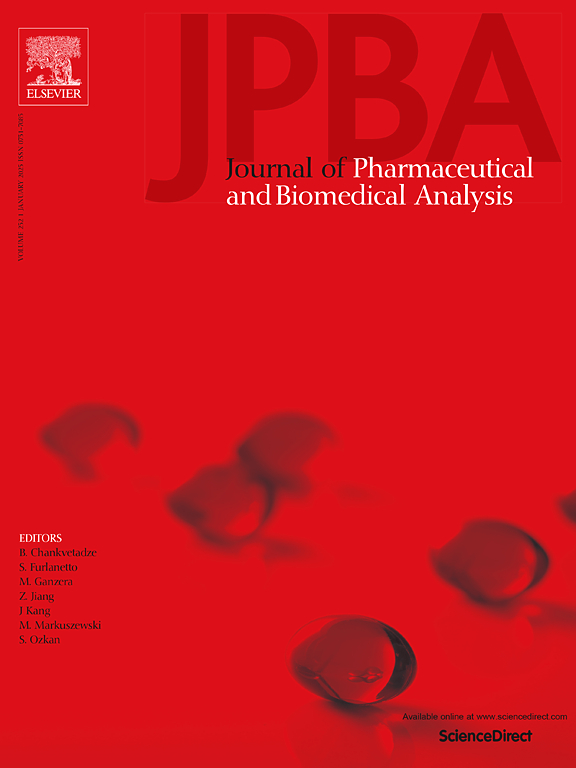纳米孔长读测序和代谢组学在体外动态肠道消化模型中的应用:以基因组为中心的超转录组学方法研究微生物TMA和SCFA代谢
IF 3.1
3区 医学
Q2 CHEMISTRY, ANALYTICAL
Journal of pharmaceutical and biomedical analysis
Pub Date : 2025-04-11
DOI:10.1016/j.jpba.2025.116896
引用次数: 0
摘要
肠道微生物群通过将膳食成分代谢成生物活性分子,包括短链脂肪酸和三甲胺,在人类健康中发挥着相关作用。了解饮食干预如何调节微生物代谢是制定减少有害代谢物(如TMA)策略的关键,TMA是促粥样硬化三甲胺- n -氧化物的前体。在这项研究中,我们将动态体外胃肠道模型(simgi®)与纳米孔测序技术和代谢组学相结合,研究红百里香提取物对微生物从左旋肉碱中代谢三甲胺的影响。元条形码、元基因组和元转录组分析与目标代谢物定量一起进行。我们的研究结果表明,微生物三甲胺的产生主要发生在横结肠和降结肠间室,这与含有gbu簇的类群的转录活性增加相一致,这与三甲胺的产生有关。红百里香提取物短暂地降低了左旋肉碱的利用率,但对总体三甲胺水平的影响有限。与此同时,短链脂肪酸分析揭示了微生物发酵模式的转变,酸胺球菌成为主要的丁酸盐生产者。在模拟条件下,碳水化合物活性酶谱鉴定出拟杆菌属和拟杆菌属是主要的粘蛋白利用者。这些发现强调了肠道微生物群对左旋肉碱和减少复合碳水化合物可用性的代谢可塑性的响应,并为以三甲胺代谢为目标的饮食干预对微生物功能的响应提供了新的见解。此外,该研究首次在动态体外胃肠模型中将基于纳米孔的宏基因组学和以基因组为中心的宏转录组学与靶向代谢组学相结合。这种多组学方法能够详细重建参与左旋肉碱利用和三甲胺形成的微生物代谢网络,为肠道微生物-饮食相互作用的机制研究提供了有力的工具。本文章由计算机程序翻译,如有差异,请以英文原文为准。
Application of nanopore long-read sequencing and metabolomics in an in vitro dynamic intestinal digestion model: A genome-centric metatranscriptomic approach to investigating microbial TMA and SCFA metabolism
The gut microbiota plays a relevant role in human health by metabolizing dietary components into bioactive molecules, including short-chain fatty acids and trimethylamine. Understanding how dietary interventions modulate microbial metabolism is key to developing strategies for reducing harmful metabolites such as TMA, a precursor of the pro-atherogenic trimethylamine-N-oxide. In this study, we integrated a dynamic in vitro gastrointestinal model (simgi®) with nanopore sequencing technology and metabolomics to investigate the impact of red thyme extract on microbial trimethylamine metabolism from L-carnitine. Metabarcoding, metagenomic, and metatranscriptomic analyses were performed alongside targeted metabolite quantification. Our results showed that microbial trimethylamine production primarily occurred in the transverse and descending colon compartments, coinciding with increased transcriptional activity of taxa harboring gbu cluster, associated with trimethylamine production. The administration of red thyme extract transiently reduced L-carnitine utilization but had a limited effect on overall trimethylamine levels. In parallel, short-chain fatty acids analysis revealed a shift in microbial fermentation patterns, with Acidaminococcus emerging as a dominant butyrate producer. Carbohydrate-active enzyme profiling identified Bacteroides and Parabacteroides genera as key mucin utilizers under the simulation conditions. These findings highlight the metabolic plasticity of the gut microbiota in response to the presence of L-carnitine and reduced complex carbohydrates availability, and provide new insights into microbial functional responses to dietary interventions targeting trimethylamine metabolism. Additionally, this study represents the first integration of nanopore-based metagenomics and genome-centric metatranscriptomics with targeted metabolomics in a dynamic in vitro gastrointestinal model. This multi-omics approach enabled a detailed reconstruction of the microbial metabolic network involved in L-carnitine utilization and trimethylamine formation, offering a powerful tool for mechanistic studies of gut microbiota–diet interactions.
求助全文
通过发布文献求助,成功后即可免费获取论文全文。
去求助
来源期刊
CiteScore
6.70
自引率
5.90%
发文量
588
审稿时长
37 days
期刊介绍:
This journal is an international medium directed towards the needs of academic, clinical, government and industrial analysis by publishing original research reports and critical reviews on pharmaceutical and biomedical analysis. It covers the interdisciplinary aspects of analysis in the pharmaceutical, biomedical and clinical sciences, including developments in analytical methodology, instrumentation, computation and interpretation. Submissions on novel applications focusing on drug purity and stability studies, pharmacokinetics, therapeutic monitoring, metabolic profiling; drug-related aspects of analytical biochemistry and forensic toxicology; quality assurance in the pharmaceutical industry are also welcome.
Studies from areas of well established and poorly selective methods, such as UV-VIS spectrophotometry (including derivative and multi-wavelength measurements), basic electroanalytical (potentiometric, polarographic and voltammetric) methods, fluorimetry, flow-injection analysis, etc. are accepted for publication in exceptional cases only, if a unique and substantial advantage over presently known systems is demonstrated. The same applies to the assay of simple drug formulations by any kind of methods and the determination of drugs in biological samples based merely on spiked samples. Drug purity/stability studies should contain information on the structure elucidation of the impurities/degradants.

 求助内容:
求助内容: 应助结果提醒方式:
应助结果提醒方式:


